The best lenses for Сanon T5i at an affordable prices.
If you have recently bought the Canon T5i, you are probably wondering which lenses to add to your photography gear arsenal. Of course, you can take stunning shots with your kit lens. However, you will never explore the full potential of your camera until you familiarize yourself with the best lenses for Canon T5i.
Even though it may seem rather strange, some interchangeable-lens camera owners never replace their kit lens with other optics. Nevertheless, even if you are a novice photographer, you will significantly increase your chances to take breathtaking photos if you try third-party lenses. So, if you are ready for shopping, hurry up to check this overview of the best lenses for Canon T5i.
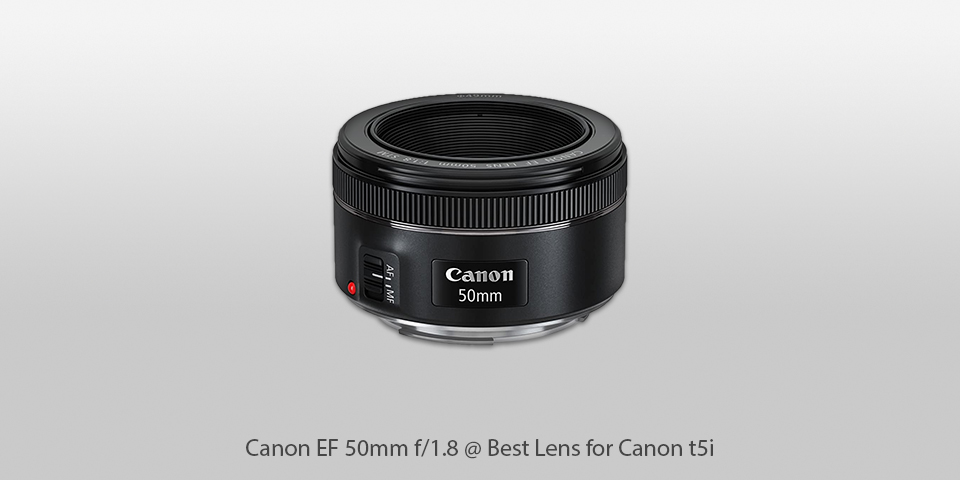
Mount: EF | Diaphragm blades: 7 | Autofocus:good | Min focus distance: 0.35m | Max magnification: 0.21x | Filter thread: 50 mm | Dimensions (WxL): 50 mm | Weight: 5.60 ounces
⊕ Compact
⊕ Quiet and smooth video focusing
⊕ Excellent price
⊖ Slight barrel distortion
The Canon EF 50mm f/1.8 produces sharp images with slight motion blur, so you may not use the flash in low-light situations. With a 50mm focal length, you can create a comfortable working distance for both you and your subject, while perfectly filling the frame. This makes this Canon EOS Rebel T5 lens a perfect option for taking portraits.
Moreover, the Canon EF 50mm f/1.8 provides the same field of view as the human eye. Due to its portability, this model can be your go-to lens for travels. The quiet Stepping Motor technology allows you to focus on the subject quickly, so you won’t miss important moments.
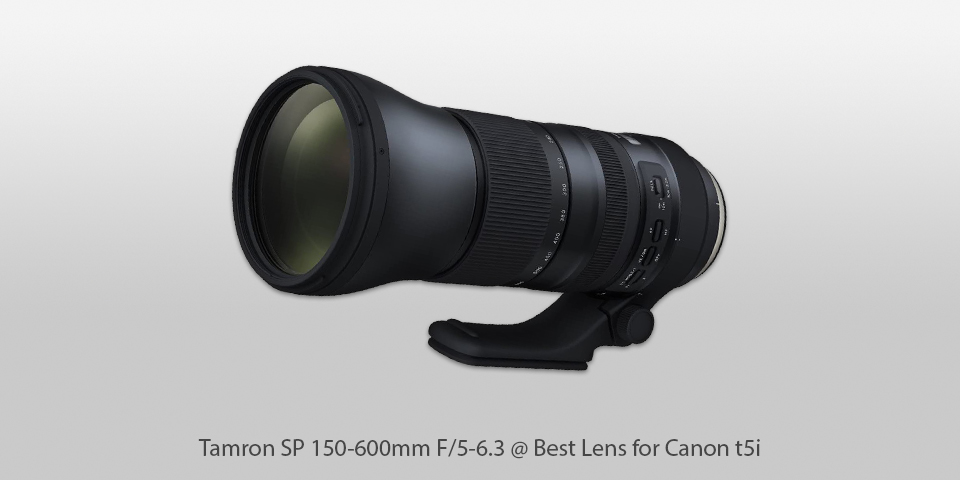
Mount: SP | Diaphragm blades:9 | Autofocus: good | Min focus distance: 2.7m | Max magnification: 0.2×| Filter thread:95 mm | Dimensions (WxL):600 mm | Weight: 4.40 lbs
⊕ Effective optical stabilization
⊕ Fast AF system
⊕ Ability to lock zoom position
⊖ Using a teleconverter limits autofocus performance
The SP 150-600mm G2 is an ultra-telephoto lens with an improved optical system that allows you to take high-quality pictures even when shooting handheld. Inspired by the success of previous models, the manufacturer upgraded the Tamron SP 150-600mm f/5-6.3 with better optics, faster autofocus, improved Vibration Compensation, fluorine coating as well as the ability to lock zoom position and work with optional 1.4x and 2x teleconverters.
Being completely redesigned based on Tamron’s rigorous quality and design standards, this lens for Canon T5i represents a perfect combination of well-thought-out construction, smooth performance, durability and ease of use.
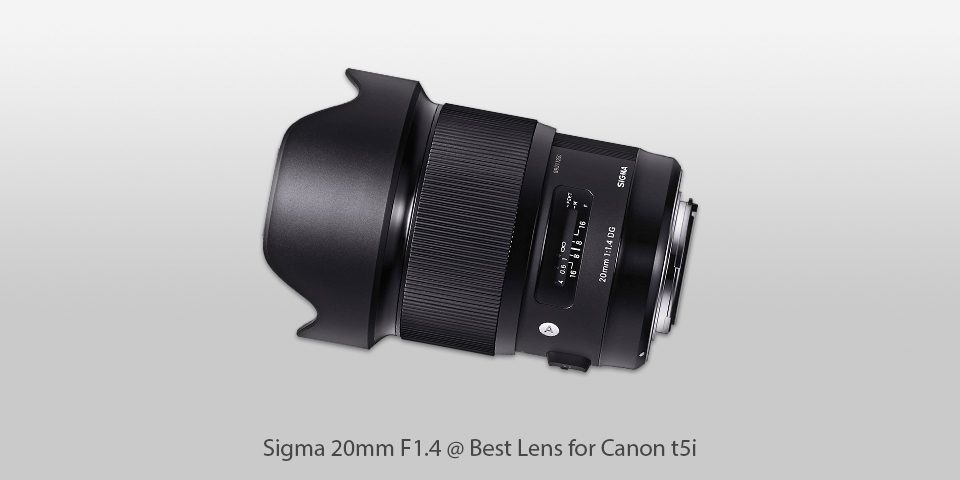
Mount: F| Diaphragm blades:9 | Autofocus: good | Min focus distance: 27.6 cm | Max magnification: 0.14×| Filter thread:20 mm | Dimensions (WxL): 20 mm | Weight: 2.10 lbs
⊕ Sharp results across the entire frame
⊕ Slight distortion
⊕ Short min focusing distance
⊖ Slightly dark edges
The Sigma 20mm F1.4 is a modern prime from the Art series that is compatible either with full-frame sensors or APS-C cameras. Nowadays, it is considered to be the widest aperture Art lens. It meets the latest set of performance requirements resulting in exceptional edge-to-edge image quality.
This model can be used as the Canon EOS Rebel T5 lens and will be a perfect addition to your camera gear due to its FLD glass and five special SLD glass elements (15 elements in 11 groups). Since the Sigma 20mm F1.4 incorporates a well-optimized and powerful optical system, it produces slight spherical aberration, axial chromatic aberration and field curvature, which allows you to enjoy breathtaking photos.
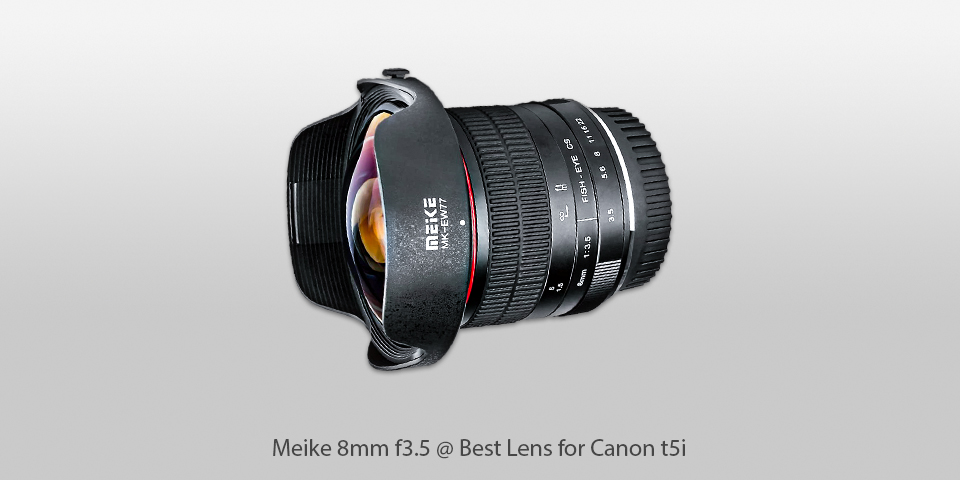
Mount: EF | Diaphragm blades:9 | Autofocus:good | Min focus distance:35cm| Max magnification: 0.22x | Filter thread: 38 mm | Dimensions (WxL): 8 mm | Weight:391g
⊕ Excellent sharpness
⊕ Minimizes lens flare
⊕ Reasonably-priced
⊖ Lens hood has a very poor fit
The multi-coating results in the high resistance to ghosting and flare. The internal construction of the Meike 8mm f3.5 includes 11 elements and 8 groups to deliver top-notch image quality. This lens is compatible with all Canon EF-Mount APS-C cameras, including such popular options as EOS Rebel T6s, T3i, T4i, T5i, T6, T6i, T6s, EOS 60D, 70D, 80D and EOS 7D, 7D MK II.
Although the Meike 8mm f3.5 can work with full-frame sensors, it will produce circular darkening at the edges of the image. Anyway, this model is a decent option among numerous Canon Rebel T5i lenses due to its robust construction and smooth performance.
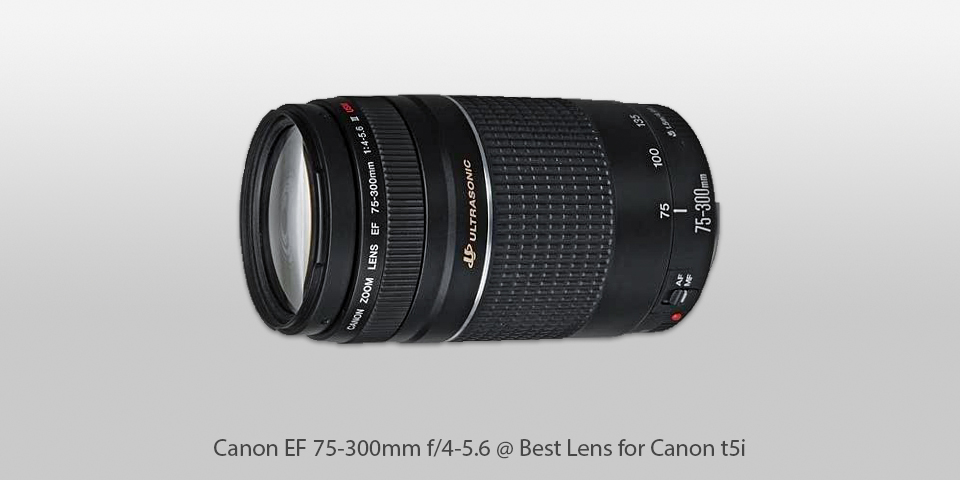
Mount: EF | Diaphragm blades: 7 | Autofocus: good | Min focus distance:1.5 m | Max magnification: 0.25x | Filter thread58: mm | Dimensions (WxL): 300 mm | Weight: 1.06 lbs
⊕ Ability to reach distant objects
⊕ Image stabilization
⊖ Soft images at all focal lengths
This zoom lens for Canon Rebel T5 boasts excellent magnification capabilities, a high level of portability and great value for money. The heaviest group of elements in the entire optical mechanism of the lens is made of lightweight glass. This allows for reducing the load on the micro Ultrasonic Motor to produce faster AF results. Due to the compact construction and smooth zooming, using the Canon EF 75-300mm f/4-5.6 is a breeze.
With this lens, you can shoot distant objects, fast-paced sports and portraits. The optical system, design and internal construction resemble the EF 75-300 mm f/4-5.6 III USM’s with the only difference being that the latter employs a DC motor to operate the AF system. The Canon manufacturer provides a one-year warranty for all its lenses, and the EF 75-300mm f/4-5.6 is no exception.
| Image | Name | Features | |
|---|---|---|---|
 |
Canon EF 50mm f/1.8
Our choice |
CHECK PRICE → | |
 |
Tamron SP 150-600mm F/5-6.3
Compact |
CHECK PRICE → | |
 |
Sigma 20mm F1.4
High quality |
CHECK PRICE → |

When shopping for the best lenses for Canon T5i, the first aspect to pay attention to is the focal length. It is measured in millimeters and determines whether a lens is a wide-angle or telephoto. Both lens types have their strong and weak points. Telephoto optics allows you to pull far away subjects closer. Also, many portrait photographers choose these lenses to make facial features appear to be more proportional. With telephoto lenses, you can create a beautiful out-of-focus background without any hassles. However, this type of lens tends to produce lower brightness and require camera stabilization to avoid motion blur in the images. Also, telephoto lenses are much bulkier than wide-angle ones.
If your photography requires a wide field of view, such as shooting landscapes, you’d better opt for a wide-angle lens. This type delivers decent brightness and DOF and is more compact compared to a regular telephoto lens. The strongest disadvantage of wide-angle lenses is that they are not suitable for portraiture due to wide-angle distortion that appears in the images taken from a close distance. Thus, the nose of the model may appear large, and the eyes may seem sunken. Also, with wide-angle lenses, the straight lines bend outwards from the center of the image.
A focal length of the lens considerably affects its angle of view. A wide-angle lens refers to a lens with focal length ranging from 18mm to 24mm. Telephoto lenses may have a focal length of 100mm, 200mm, 400mm, etc. On full-frame sensors, the 50mm occupies the middle ground between wide-angle and telephoto. 50mm is considered to be standard or normal camera lenses. There are different types of lens based on full-frame equivalent focal length.
Wide-angle lenses are suitable for shooting landscapes or working in enclosed spaces, while telephoto lenses are a choice of wildlife and sports photographers. The telephoto range from 50mm to 105mm is an excellent option for portraiture. However, you can choose a lens with more extended focal length coverage. Wide-angle optics isn’t recommended for taking portraits as your pictures may appear distorted. That is the reason your nose looks larger when you take a selfie on your smartphone, since modern phones employ wide-angle lenses. Nevertheless, this distortion highlights distance. That is why wide-angle lenses are sought-after among photographers who shoot skateboarding.

Carefully study the focal length values to determine which coverage works for you. This is a vital factor when shopping for the Canon Rebel T5i lenses. The focal length directly correlates to a zoom ratio of the lens. There are lenses with a fixed focal length which are often called primes, for example, 14mm, 24mm, 35mm, 35mm, 50mm, 70mm, 100mm, 150mm, 600mm, etc. Also, the modern market includes lenses with a variable focal length, for example, 10-20mm, 24-70mm, 70-200mm, 100-400mm, etc. The lenses with a sliding focal length are popular for their flexibility.
The smaller the focal length, the wider field of view you will achieve in your images. If you preserve the same position for different focal lengths, you will see the difference. When shooting at 10mm, you will get a very wide field of view. At 55mm, the distant subjects will appear closer, and the field of view will be narrower. With 20mm focal length, you can reach even more faraway objects.
Keep in mind that the above-mentioned focal length ranges will work with full-frame cameras. An 18mm lens will produce the same equivalent on full-frame cameras. If you attach the 18mm lens on the APS-C sized sensors, it will have the equivalent of 29mm.
Examine the diagram below to learn the angles of view at different focal lengths.
1 – The universal 50mm. If you can buy only one extra lens, pick the one with a 50mm focal length.
2 – The ultra-wide-angle. In case you can afford two additional lenses, buy a 50mm lens and then shop for a wide-angle lens.
3 – A macro lens will also be an addition to your personal photography kit.
The most versatile option for photographers is the 50mm prime lens. However, many novice photographers don’t consider 50mm as an additional lens since their 18-55mm kit lens already covers the 50mm focal length.
A 35mm lens delivers a wider field of view than 50mm optics and produces less distortion than a 24 mm lens. That is why it is a universal option if you need a standard lens with a wide field of vision.
If you want to take stunning landscape pictures, you will need a lens that delivers good sharpness, and a 50mm prime will be an excellent option. The lack of additional moving parts usually required to change the focal lengths result in sharper images. Like most lenses, its sweet spot is not wide open, but it normally falls between the f/4 to f/5.6 range.

 Rating
Rating